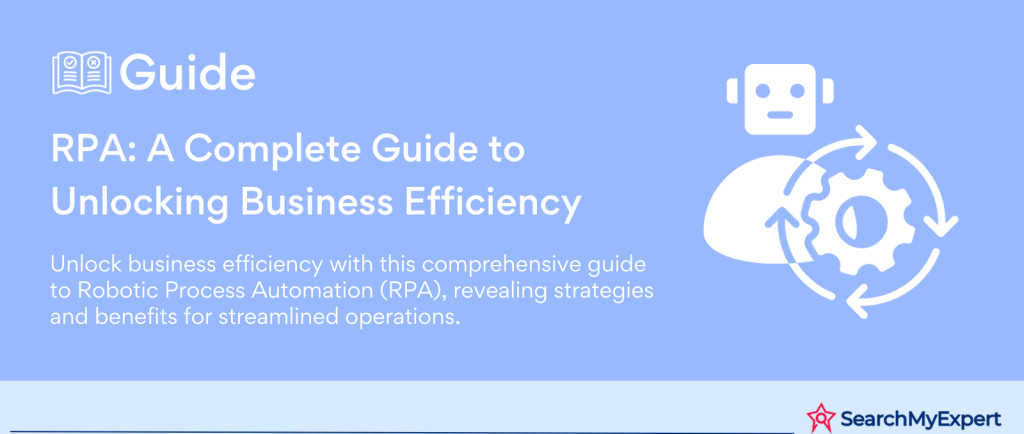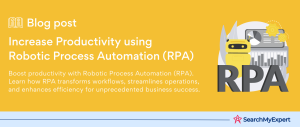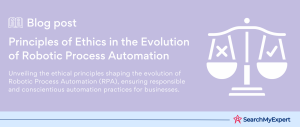What is Robotic Process Automation (RPA)?
Robotic Process Automation, commonly known as RPA, represents a significant leap in the way businesses automate and streamline their processes. At its core, RPA involves the utilization of software robots or ‘bots’ to imitate human actions within digital systems, thereby executing business processes faster, more accurately, and tirelessly compared to manual efforts.
Definition and Key Concepts
- Software Robots: These digital workers perform tasks within computer systems, mimicking human interactions such as clicking, typing, and extracting data.
- Process Automation:
RPA automates routine, rule-based tasks, allowing employees to focus on more strategic work. - User Interface Interaction: Unlike traditional automation that requires programming deep within a system’s backend, RPA bots operate at the user interface level, making them easier to deploy and manage.
- Scalability and Flexibility: RPA solutions are easily scalable and can adapt to changing business needs.
- Non-intrusive Nature:
RPA can be implemented without altering the existing IT infrastructure, making it a cost-effective automation solution.
Differentiating RPA from Artificial Intelligence (AI) and Machine Learning (ML)
While RPA, AI, and ML are often mentioned in the same breath, they have distinct functions:
- RPA is about automating rule-based tasks without the need for human intervention. It’s great for repetitive, predictable tasks but cannot learn or adapt beyond its initial programming.
- AI, on the other hand, involves creating systems that can perform tasks that typically require human intelligence. This includes problem-solving, understanding natural language, and recognizing patterns.
- Machine Learning, a subset of AI, gives systems the ability to automatically learn and improve from experience. ML algorithms can analyze data, learn from it, and make informed decisions based on this learning.
The Potential and Benefits of RPA
The adoption of RPA technology brings numerous benefits:
- Efficiency: Automating routine tasks reduces the time and resources needed to complete them.
- Accuracy:
RPA bots are programmed to follow rules, reducing the likelihood of errors. - Productivity:
Employees are freed from tedious tasks, allowing them to focus on more valuable work. - Cost Savings: Efficiency and accuracy lead to reduced operational costs.
- Customer Satisfaction:
Faster, more accurate services enhance customer experiences. - Agility:
RPA can adapt to changing business landscapes, offering flexibility in operations.
Automation Landscape and Repetitive Tasks
Robotic Process Automation (RPA) has revolutionized the way businesses handle their operations, specifically in automating tasks that are repetitive and rule-based. Understanding which tasks are suitable for RPA and the impact of this technology on business processes is crucial for any organization looking to enhance efficiency and productivity.
Identifying Tasks Suitable for RPA Automation
- Data Entry and Processing:
This includes inputting data into systems, consolidating information from various sources, and updating records. RPA excels in these areas due to its precision and speed. - Form Filling: Automating the process of filling out forms, whether for internal use or customer interactions, is a prime example of RPA in action.
- Repetitive Processes:
Any task that involves repetition, such as order processing, invoice generation, and payroll management, is ideal for RPA. - Report Generation: Compiling data and generating regular reports, such as financial summaries or sales performance analyses.
- Email Automation:
Sorting, responding to, or forwarding emails based on predefined criteria. - Data Validation and Verification:
Checking data for accuracy and consistency, which is crucial in sectors like banking and insurance.
Impact of RPA on Business Processes and Workflows
- Streamlining Operations: RPA can integrate disparate systems, ensuring smooth transitions between different process stages.
- Enhancing Workflow Efficiency:
Automating routine tasks makes workflows more efficient, reducing bottlenecks and delays. - Employee Empowerment:
Removing repetitive tasks from employees’ workload allows them to focus on more strategic and creative tasks.
Benefits of Automating Repetitive Tasks
- Increased Efficiency and Productivity: RPA bots work 24/7 without breaks, thus significantly increasing productivity. They can also complete tasks more rapidly than human workers.
- Reduced Costs and Errors:
By automating routine tasks, businesses can save on labor costs. Also, bots are less prone to errors compared to humans, reducing the costs associated with mistakes. - Improved Data Accuracy and Compliance: RPA ensures that data is processed accurately, which is crucial for compliance in industries like finance and healthcare. This accuracy also supports better decision-making.
- Scalability:
Businesses can scale their RPA efforts up or down based on demand without additional human resources. - Customer Satisfaction:
Faster and more accurate services lead to improved customer experiences. - Adaptability:
RPA technology can be adapted to a wide range of tasks and can be reconfigured as processes evolve.
RPA Technology and Tools
The implementation of Robotic Process Automation (RPA) within an organization hinges on understanding its core components and the various tools available in the market. This knowledge is essential for selecting the right RPA solution that aligns with specific business needs.
Core Components of RPA Software
- Robots (Software Bots):
These digital workers perform tasks by mimicking human actions. They can interact with various applications and systems to execute predefined workflows. - User Interfaces (UIs):
The UIs of RPA tools are designed for ease of use. They allow users to design, test, and manage bots with minimal technical expertise. These interfaces often provide a visual representation of workflows and allow for drag-and-drop programming. - Scripting Languages and Recorders: RPA tools utilize scripting languages to define the actions of bots. Additionally, many RPA platforms come with recorders that can capture user actions and translate them into scripts, simplifying the bot creation process.
Overview of Popular RPA Platforms and Tools
- UiPath: Known for its user-friendly interface and extensive library of pre-built activities. It is suitable for businesses of all sizes.
- Blue Prism:
Offers a robust and secure platform, often preferred for large-scale enterprise deployments. - Automation Anywhere: Combines traditional RPA with cognitive elements like natural language processing and reading unstructured data.
- Microsoft Power Automate:
Integrated with other Microsoft services, it’s a good choice for organizations heavily using Microsoft products.
Considerations for Choosing the Right RPA Tool
- Ease of Use:
Consider tools that offer intuitive interfaces and require minimal coding expertise. - Scalability:
The tool should be able to scale up or down based on the evolving needs of the business. - Security:
Given the sensitivity of the data that RPA bots handle, a high level of security is crucial. - Integration Capabilities:
Ensure the RPA tool can integrate seamlessly with existing systems and software used by the organization. - Cost:
Evaluate the cost of the tool against its features and the potential return on investment. - Support and Community:
Access to good customer support and a vibrant user community can be invaluable, especially for troubleshooting and best practices. - Customization and Flexibility: The tool should offer customization options to cater to specific business processes and requirements.
- Analytics and Reporting: Look for tools with robust analytics and reporting features to monitor bot performance and business impact.
Impact of RPA on Business Processes and Workflows
- Streamlining Operations:
RPA can integrate disparate systems, ensuring smooth transitions between different process stages. - Enhancing Workflow Efficiency:
Automating routine tasks makes workflows more efficient, reducing bottlenecks and delays. - Employee Empowerment:
Removing repetitive tasks from employees’ workload allows them to focus on more strategic and creative tasks.
Benefits of Automating Repetitive Tasks
- Increased Efficiency and Productivity: RPA bots work 24/7 without breaks, thus significantly increasing productivity. They can also complete tasks more rapidly than human workers.
- Reduced Costs and Errors:
By automating routine tasks, businesses can save on labor costs. Also, bots are less prone to errors compared to humans, reducing the costs associated with mistakes. - Improved Data Accuracy and Compliance:
RPA ensures that data is processed accurately, which is crucial for compliance in industries like finance and healthcare. This accuracy also supports better decision-making. - Scalability:
Businesses can scale their RPA efforts up or down based on demand without additional human resources. - Customer Satisfaction:
Faster and more accurate services lead to improved customer experiences. - Adaptability:
RPA technology can be adapted to a wide range of tasks and can be reconfigured as processes evolve.
Implementing RPA: A Phased Approach
Implementing Robotic Process Automation (RPA) in an organization is a significant undertaking that requires a structured and phased approach. Each phase plays a critical role in ensuring the successful deployment and operation of RPA bots. Proper planning, preparation, and change management are vital across all these phases.
Discovery and Assessment
- Identify Processes:
The first step involves identifying and evaluating potential processes for automation. Look for tasks that are repetitive, rule-based, and have high volume. - Feasibility Analysis: Assess the technical and economic feasibility of automating these processes. This includes understanding the technology requirements and potential return on investment.
- Stakeholder Engagement:
Engage with stakeholders to understand their needs and concerns. This helps in aligning the RPA project with business objectives.
Process Selection and Design
- Choosing the Right Processes: Based on the assessment, select the most suitable processes for RPA implementation. Prioritize processes that offer the highest value and are least complex to automate.
- Process Mapping:
Document the selected processes in detail. This includes mapping out each step and understanding the decision points within the process. - Designing the Solution:
Develop a detailed design of how the RPA bots will execute the chosen processes. This involves defining the workflow, the rules, and the interactions with other systems.
Development and Testing
- Bot Development:
Develop the RPA bots using the chosen RPA tool. This involves coding, setting up the workflow, and configuring the bots to perform the desired tasks. - Testing: Rigorously test the bots in a controlled environment to ensure they perform as expected. Testing should cover various scenarios to identify any issues or bugs.
Deployment and Monitoring
- Rolling Out the Bots:
Deploy the bots into the live environment. This should be done gradually, starting with a pilot phase to monitor performance and impact. - Continuous Monitoring:
Once deployed, continuously monitor the bots to ensure they are operating efficiently and correctly. Adjust and optimize as necessary. - Feedback Loop:
Establish a feedback loop to gather insights from users and make improvements.
Importance of Planning, Preparation, and Change Management
- Strategic Planning:
Effective planning is crucial to align the RPA initiative with business goals and to manage resources efficiently. - Preparation:
Adequate preparation, including training for staff and setting up the necessary infrastructure, is vital for a smooth implementation. - Change Management: RPA implementation brings significant changes to workflows and employee roles. Effective change management is essential to address concerns, manage expectations, and ensure a smooth transition.
Real-World Applications and Case Studies of RPA
Robotic Process Automation (RPA) has been implemented successfully across various industries, demonstrating its versatility and efficiency. By showcasing real-world examples and case studies, we can understand how RPA not only streamlines operations but also significantly enhances the user experience.
Financial Services
- Automated Loan Processing:
A leading bank implemented RPA to automate its loan approval process. This reduced the processing time from days to hours, significantly improving customer satisfaction. The bots were programmed to extract data from loan applications, run credit checks, and process approvals or rejections based on predefined criteria. - Fraud Detection:
Another example is fraud detection. RPA bots continuously monitor transactions to identify patterns that indicate fraudulent activity, allowing for rapid response and reduced financial losses.
Healthcare
- Patient Appointment Scheduling:
A healthcare provider used RPA to automate its patient appointment scheduling system. The bots were able to handle appointment bookings, cancellations, and rescheduling, freeing up staff time and reducing wait times for patients. - Medical Billing and Claims Processing:
RPA was deployed to streamline the medical billing process. Bots automatically processed claims and updated patient records, ensuring faster billing cycles and improved accuracy, thereby enhancing patient satisfaction and compliance.
Manufacturing
- Supply Chain Management: In the manufacturing sector, a company uses RPA bots to manage its supply chain. The bots automated the ordering of materials, tracking of shipments, and inventory management, resulting in reduced lead times and increased efficiency.
- Quality Control:
RPA also aided in quality control processes by automatically analyzing product specifications and identifying defects, ensuring higher quality standards.
Customer Service
- Automated Responses and Ticketing: A customer service center implemented RPA for handling customer inquiries and complaints. Bots were used to automatically generate tickets, categorize them based on the query, and route them to the appropriate department, leading to faster response times and improved customer satisfaction.
- Live Chat Assistance: RPA bots were programmed to provide initial responses in live chat scenarios, offering immediate assistance to customers and escalating complex queries to human agents.
Enhancing User Experience and Streamlining Operations
Across all these industries, RPA has played a pivotal role in enhancing user experiences by:
- Reducing Wait Times:
Automated processes ensure quicker responses to customer or patient inquiries. - Increasing Accuracy:
Minimizing human errors in tasks like data entry and billing. - Improving Efficiency: Automating routine tasks allows employees to focus on more strategic and customer-focused initiatives.
- Cost Reduction: Lower operational costs through efficient process management.
The Future of RPA and Emerging Trends
The landscape of Robotic Process Automation (RPA) is rapidly evolving, influenced by advancements in technology and changing business needs. The future of RPA, particularly its integration with Artificial Intelligence (AI) and Machine Learning (ML), holds immense potential. This evolution is steering toward more sophisticated forms of automation like cognitive automation and hyperautomation. However, these advancements also raise important ethical considerations and concerns about the human impact.
Integration of RPA with AI and ML
- Enhanced Capabilities:
The integration of AI and ML with RPA is creating more intelligent bots that can handle complex, non-rule-based tasks. This includes natural language processing, decision-making under uncertainty, and learning from unstructured data. - Predictive Analytics:
ML algorithms enable RPA bots to predict future trends and outcomes based on historical data, enhancing decision-making processes in businesses. - Increased Scope of Automation: AI and ML expand the scope of processes that can be automated, including those that require an understanding of context or pattern recognition.
Cognitive Automation and Hyperautomation
- Cognitive Automation:
This refers to the combination of RPA with AI to create bots that can make decisions based on unstructured data and learn from their interactions. Cognitive automation can handle complex tasks like interpreting text and speech or making judgment-based decisions. - Hyperautomation:
A term coined by Gartner, hyperautomation refers to the end-to-end automation beyond RPA by combining it with a range of AI tools, process mining, analytics, and other advanced technologies. It aims to automate more complex and knowledge-based work.
Ethical Considerations and Human Impact
- Job Displacement:
One of the primary concerns with RPA is the potential for job displacement. As bots take over more tasks, there is a fear of reduced demand for human labor. - Reskilling and Upskilling: To address this, businesses are focusing on reskilling and upskilling their workforce to work alongside RPA and AI technologies, creating new roles and opportunities.
- Ethical Use of AI:
Ensuring the ethical use of AI in RPA is crucial. This includes addressing biases in AI algorithms and ensuring transparency in automated decisions. - Human Oversight:
Maintaining human oversight is essential, especially in critical sectors like healthcare and finance, to ensure that automation aligns with ethical standards and societal values.
Key Takeaways and Benefits of RPA
- Efficiency and Productivity:
RPA significantly reduces the time required to complete routine tasks, leading to increased productivity. - Accuracy and Compliance: Automation minimizes human errors, ensuring greater accuracy and compliance with regulatory requirements.
- Cost Reduction:
By automating tasks, businesses can save on labor costs and reduce operational expenses. - Scalability:
RPA solutions can be scaled up or down to meet changing business needs. - Employee Empowerment:
Freeing employees from monotonous tasks allows them to focus on strategic and creative work, enhancing job satisfaction. - Enhanced Customer Experience:
Faster and more accurate services lead to improved customer satisfaction.
Encouraging Further Exploration and Learning
To fully harness the potential of RPA, continuous learning and adaptation are essential. Businesses and individuals should stay informed about the latest developments in RPA technology and its applications.
Resources for Further Information and Opportunities
- Online Courses and Certifications: Platforms like Coursera, Udemy, and LinkedIn Learning offer courses on RPA and related technologies. Certifications from RPA vendors like UiPath, Blue Prism, and Automation Anywhere can provide in-depth knowledge and practical skills.
- Webinars and Workshops:
Many technology consulting firms and RPA vendors host webinars and workshops that can provide insights into the latest trends and best practices in RPA implementation. - Industry Reports and Case Studies: Resources like Gartner reports, Forrester, and McKinsey publications offer valuable insights into RPA trends, case studies, and market analysis.
- Community Forums and Groups:
Online communities on platforms like Reddit, Stack Overflow, and LinkedIn groups are great for networking, sharing experiences, and seeking advice from peers. - Blogs and Newsletters: Following blogs by RPA experts and subscribing to industry newsletters can keep you updated on the latest news and developments.
Conclusion:
Robotic Process Automation (RPA) emerges as a pivotal technology in the realm of business process automation. By enabling the automation of routine and repetitive tasks, RPA not only elevates operational efficiency and accuracy but also reshapes the workforce dynamics, allowing employees to focus on more strategic and innovative activities. The integration of RPA with AI and ML is ushering in an era of cognitive automation and hyperautomation, opening new horizons for businesses to explore.
However, the journey of RPA implementation necessitates careful planning, continuous learning, and adapting to emerging trends while considering the ethical implications and human impact. As the landscape of automation continues to evolve, RPA stands as a beacon of transformation and efficiency, offering substantial benefits for those who navigate its potential wisely. The future of RPA is not just about technology; it’s about strategically augmenting human potential and reshaping business processes for a more efficient and innovative tomorrow.
Partner with leading Robotic Process Automation Service Agencies for advanced automation.
Further Reading
- Benefits of Robotic Process Automation
- Tools and Technologies in Robotic Process Automation
- Best Practices in Robotic Process Automation Implementation
- Robotic Process Automation in Banking and Finance
- Overcoming Challenges in Robotic Process Automation Adoption
- Measuring ROI of Robotic Process Automation Projects
Table of Contents
Toggle






